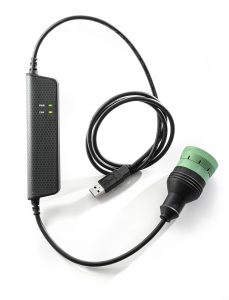The ISO 11783 Standard
Modern agricultural and forestry vehicles include tractors and mounted, semi-mounted, towed or self-propelled implements. These vehicles use on-board electronic systems for real-time communication, data capturing and analysis. The International Organization for Standardization (ISO) has defined the ISO 11783 standard to define and standardize data transfer in these equipments. Its purpose is to achieve inter-operability and compatibility in data transfer between the sensors, actuators, control units, memory and display units in these tractors or any implements. This is done by specifying a serial data network for control and communications between the multiple electronic control units (ECUs) interconnected through the in-vehicle network. Thus the ISO 11783 provides an Open Systems Interconnections (OSI) model for on-board electronic systems in agricultural and forestry equipment.
Implementing ISO 11783 through ISOBUS
The ISO 11783 standard is implemented using the ISOBUS Software Stack that specifies a serial data network for control and communications in agricultural and forestry tractors and machinery. The ISOBUS software stack is often a pre-packaged software solution developed in compliance with the ISO 11783 Standard. This realizes the in-vehicle network communication between the tractor ECUs and implement ECUs. ISOBUS is originally based on the popular SAE J1939 specification that includes the CAN Bus, the robust vehicle bus standard that facilitates communication between on-board microcontrollers and devices. SAE J1939 is the recommended practice for vehicle bus used for communication and diagnostics among vehicle components in commercial vehicle applications. The Agricultural Industry Electronics Foundation (AEF), an international partnership of leading agricultural tractor and implement manufacturers promotes the ISOBUS standard and coordinates certification tests for the ISO 11783 standard compliance. This partnership promotes the electronic standardization of different equipments and ensures the inter-operability and compatibility between cross-manufacturer ISOBUS implements and tractors in the agricultural industry. AEF provides the following benefits for its member manufacturers:
- Certification of the ISOBUS products and its incorporation into the AEF ISOBUS database for enhanced public and market visibility to boost sales and service.
- Provides the AEF ISOBUS Conformance Test Tool to help making the products ready for the AEF ISOBUS Conformance Test. This speeds up the development of the ISOBUS products.
- Knowledge and support from AEF to the manufacturers’ engineers.
- Provision for getting engaged with the AEF Project Team that allows the manufacturer teams to participate and influence the development of international agriculture industry standards.
ISOBUS for Compatibility and Inter-Operability
Agricultural tractors and implements contain the following basic electronic control units, connectors and devices:
- Tractor ECU
- Implement ECU
- Implement Breakaway Connector
- Implement Bus
- Auxiliary Input
- Virtual Terminal
The composite tractor management unit consists of the above on-vehicle components along with off-vehicle systems such as the File Server, Task Controller and Diagnostic Units. These systems are managed through a Farm PC or Farm Mobile Computation device installed with a web-based or mobile application.
In the agriculture and automotive industry ecosystem, all these components, systems, devices and the vehicles are manufactured and serviced by different Original Equipment Manufacturers (OEMs) and Automotive Suppliers. It is essential to maintain compatibility and to ensure inter-operability between these various components so that the end-user can use the tractor and multiple implements manufactured by same or different OEMs with flawless coordination. For this, the ISOBUS software stacks are used to standardize and provide the serial data communication between the various ECUs, Connectors and Virtual Terminal through a plug-and-play approach. This also helps tractor and implement OEMs to integrate embedded devices and electronic components supplied by third party automotive suppliers in the industry ecosystem.
Kvaser and ISO 11783
The Kvaser Leaf Light HS v2 J1939-13 Type II provides an efficient and simple means for connecting a PC or mobile computer with the CAN communication link of any J1939 compliant agricultural or industrial vehicle. It uses the SAE J1939-13 standard that specifies the diagnostic connectors used for interconnecting off-board diagnostic tools and on-board devices on the J1939 vehicle.
It has the Standard Type “A” USB 2.0 connector at one end for off-board connection and a J1939-13 Type II compliant CAN connector at the other end for on-board connection to get diagnostic data. It supports 250 and 500 Kbps vehicle networks and is capable of sending upto 8000 messages per second, each time-stamped with 100 microsecond accuracy. The Galvanic Isolation shields this device from electrical shocks and power surges. Along with this, the broad temperature range of -20 to +70 °C and the engineering-grade thermoplastic casing material PA66 makes the Kvaser Leaf Light tough and durable in the muddy and wet agricultural environment.
